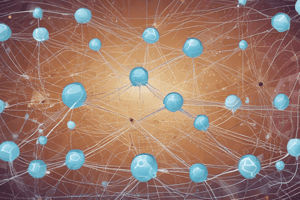Podcast
Questions and Answers
What type of database is created by the Link-state database?
What type of database is created by the Link-state database?
- Topology table (correct)
- Neighbor table
- Routing table
- Adjacency table
What is an advantage of Multi-area OSPF over single area OSPF?
What is an advantage of Multi-area OSPF over single area OSPF?
- Increased link-state update overhead
- Increased frequency of SPF calculations
- Larger routing tables
- Reduced frequency of SPF calculations (correct)
Which OSPF packet contains one or more LSAs?
Which OSPF packet contains one or more LSAs?
- Hello packet
- Acknowledgement packet
- Database description packet
- LSU link-state update packet (correct)
What is the purpose of the Hello packet in OSPF?
What is the purpose of the Hello packet in OSPF?
Which database is unique for each router in OSPF?
Which database is unique for each router in OSPF?
What is identical on all OSPF routers within a single area?
What is identical on all OSPF routers within a single area?
What is the purpose of the LSU packet in OSPF?
What is the purpose of the LSU packet in OSPF?
What is the benefit of reduced link-state update overhead in Multi-area OSPF?
What is the benefit of reduced link-state update overhead in Multi-area OSPF?
What is the purpose of the Database Description packet?
What is the purpose of the Database Description packet?
What is common to all OSPF routers within a single area?
What is common to all OSPF routers within a single area?
What is the difference between the Adjacency and Forwarding databases?
What is the difference between the Adjacency and Forwarding databases?
What is the result of reduced frequency of SPF calculations in Multi-area OSPF?
What is the result of reduced frequency of SPF calculations in Multi-area OSPF?
Flashcards are hidden until you start studying
Study Notes
OSPF Databases
- Adjacency database creates the neighbor table
- Link-state database (LSDB) creates the topology table
- Forwarding database creates the routing table
- Each router has a unique Adjacency and Forwarding database (Routing and Neighbor table)
Multi-Area OSPF Advantages
- Smaller routing tables
- Reduced link-state update overhead
- Reduced frequency of SPF calculations
OSPF Packets
- LSU (Link-State Update) packet contains one or more LSAs (Link-State Advertisements)
- LSU packet is used to send specifically requested link-state records
- Hello packet is used to discover neighbors and build adjacencies between them
- Database Description packet is used to check for database synchronization between routers
OSPF Router Characteristics
- Link-state database is identical on all OSPF routers within a single area
OSPF Databases
- Adjacency database creates the neighbor table
- Link-state database (LSDB) creates the topology table
- Forwarding database creates the routing table
- Each router has a unique Adjacency and Forwarding database (Routing and Neighbor table)
Multi-Area OSPF Advantages
- Smaller routing tables
- Reduced link-state update overhead
- Reduced frequency of SPF calculations
OSPF Packets
- LSU (Link-State Update) packet contains one or more LSAs (Link-State Advertisements)
- LSU packet is used to send specifically requested link-state records
- Hello packet is used to discover neighbors and build adjacencies between them
- Database Description packet is used to check for database synchronization between routers
OSPF Router Characteristics
- Link-state database is identical on all OSPF routers within a single area
Studying That Suits You
Use AI to generate personalized quizzes and flashcards to suit your learning preferences.




